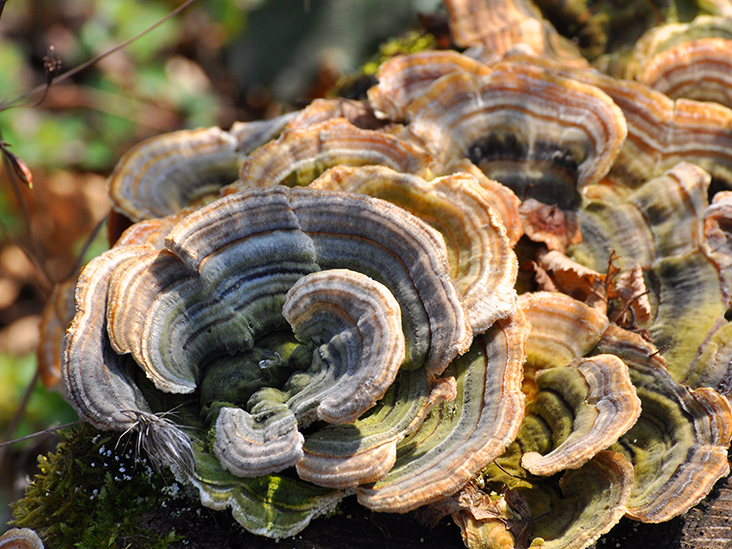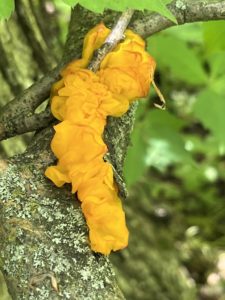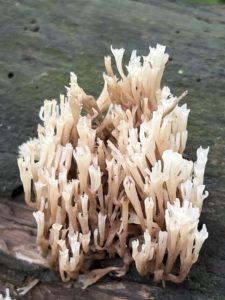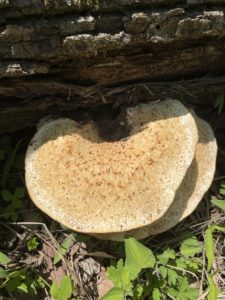
A Foray into Fungi
When you think of mushrooms, are you delighted or disgusted? When you see a mushroom in your lawn, do you want to get closer to it or get rid of it? No matter how you feel about mushrooms and fungi, they have a lot to offer us.
Fungi play a crucial role in our environment, serving as a food source to wildlife and a key decomposer in our forests. Despite this, humans still have a lot to learn about fungi. Though there are countless fungi species still left to be discovered, some of the most interesting ones can be found right outside our doors. Let’s take a look at some common fungi that call our parks home.
Witch’s Butter (Tremella mesenterica)

Photo: Caitlin May, Central Park East Woods
Witch’s butter is just one of many members of a group of fungi called the jelly fungi. These fungi are known for their gelatinous, or jelly-like, consistency. During dry periods, this fungus can become shriveled and small. When it becomes moist again, it returns to its former gelatinous glory. This species is most often seen on dead or decaying deciduous trees.
According to Dr. Tom Volk, a mycologist (a.k.a fungi scientist), the witch’s butter fungus gets its name from medieval Europe. Legend has it that this fungus would appear on your gate or doorway when you had been cursed by a witch! The only way to lift the spell was to prick the fungus with a pin and allow the juices to drain.
Crown-tipped Coral Fungus (Artomyces pyxidatus)

Photo: Caitlin May, Hazel Landing Park
The crown-tipped coral fungus is one of the only coral fungus species that grows directly on wood. Its crown-shaped tips at the end of each curved arm give it a unique appearance. Though it looks like our well-known ocean corals, they are not related.
This species acts as a saprobe. Saprobes are the ultimate recyclers! They feed on dead or decaying organic matter and help with the decomposition process. This helps recycle nutrients back into the environment where they can be used by other living things, including humans. Saprobic fungi like this one help make the world go round!
Dryad’s Saddle (Cerioporus squamosus)

Photo: Caitlin May, Hazel Landing Park
Dryad’s saddle gets its name from Greek mythology. Dryads were thought to be small, tree-dwelling nymphs or sprites (elves and fairies!). The shape and size of these mushrooms led our ancestors to believe that they could be used as saddles for dryads to ride on. Another common name for this mushroom is Pheasant Back. This name comes from the feathery appearance of the top of the mushroom, which has similar colors as a pheasant.
You might be able to spot this species on either a living or dead tree. It acts as a parasite to living trees and serves as a decomposer for dead trees. These are most often seen in the spring and can grow to be 12 inches wide!
How can I learn more?
These species are just a few of the many you might be able to find in our 15 parks and 4 greenways. You might even be able to find some in your own backyard! Tools like iNaturalist help you identify a species using photos taken on your phone. Some of our best parks to spot fungi are Hazel Landing Park and Central Park.
You can learn more about fungi, where to find them, and how to identify them at our first ever Summer Foray. A foray is when a group of people go into a forest or other natural area to look for fungi. Some fungi enthusiasts might look for edible mushrooms, while others may be looking to collect specimens for scientific study. The goal of our Summer Foray is to find as many fungi species as possible in Hazel Landing Park. Our findings will be documented in iNaturalist and will contribute to the North American Fungal Diversity Survey.
Come out to join us at Hazel Landing Park and see what fungi you can find! For more information and to register for the event, click here. We can’t wait to see you there!
Additional Resources:
Fantastic fungi and where to find them
Mushrooms of the Upper Midwest (2nd Edition), Teresa Marrone & Kathy Yerich
